|
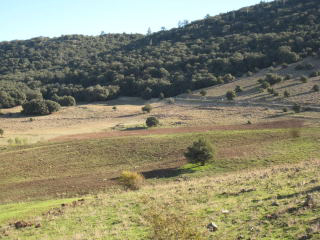
Atlas Foot hills
Left
Fez and started the climb into the Atlas Mountains. Perhaps I
shouldn’t have been recording this day since it was my second day of
dysentery and I wasn’t thinking clearly. At some point along the road,
I asked for a bathroom 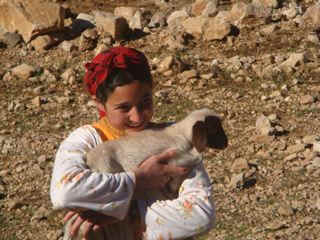 stop and a scrubby bush was my only cover. As I
started to get up from squatting, I lost my balance and fell over,
hitting my forehead on a rock. Haji came running up and got me back to
the bus where Fred got a bandage on the cut. From then on, I must say,
my ability to remember scenes was diminished. After the bus had gone on
a little ways, I realized that in the confusion after the fall, I had
left my purse back at the bush. Tomi made a really tight turn on the
narrow road and back we went. Once stop and a scrubby bush was my only cover. As I
started to get up from squatting, I lost my balance and fell over,
hitting my forehead on a rock. Haji came running up and got me back to
the bus where Fred got a bandage on the cut. From then on, I must say,
my ability to remember scenes was diminished. After the bus had gone on
a little ways, I realized that in the confusion after the fall, I had
left my purse back at the bush. Tomi made a really tight turn on the
narrow road and back we went. Once 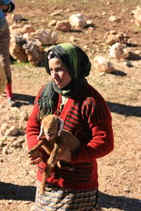 we got to the spot, several people
went out looking. Haji talked to some young men who were nearby and
quickly determined that the man walking away down the road had my purse.
Off he ran to catch up with him and brought both the man and my purse
back to the bus. We were all most appreciative and rewarded the man for
rescuing the bag. Haji was wonderful. My trip would have really ended
there if I had lost the bag containing money, credit cards, and
passport. Why I even thought it necessary to take the bag to the bush is
an unanswerable question. we got to the spot, several people
went out looking. Haji talked to some young men who were nearby and
quickly determined that the man walking away down the road had my purse.
Off he ran to catch up with him and brought both the man and my purse
back to the bus. We were all most appreciative and rewarded the man for
rescuing the bag. Haji was wonderful. My trip would have really ended
there if I had lost the bag containing money, credit cards, and
passport. Why I even thought it necessary to take the bag to the bush is
an unanswerable question.
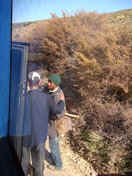
The shepherd returned Kristie's bag
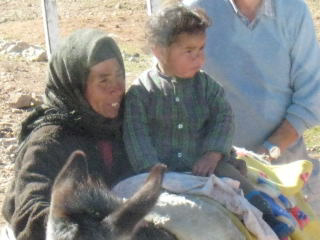 So,
on with the journal. As we climbed the Atlas Mountains, we saw a group
of Bedouin women and children at the side of the road with their
animals. One young woman was carrying a baby lamb. With some dirhan
changing hands, we could take their pictures. There were no men in the
group – we assumed they were off tending the sheep. Further on we
spotted a black Berber tent and stopped to investigate. The tent itself
was being used to shelter So,
on with the journal. As we climbed the Atlas Mountains, we saw a group
of Bedouin women and children at the side of the road with their
animals. One young woman was carrying a baby lamb. With some dirhan
changing hands, we could take their pictures. There were no men in the
group – we assumed they were off tending the sheep. Further on we
spotted a black Berber tent and stopped to investigate. The tent itself
was being used to shelter 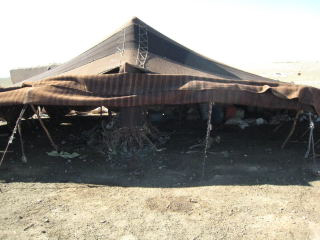 farm
and household equipment – very rustic. There was a man in front of the
nearby small stucco house and with more dirhan exchange we could go
through it. It was very rustic with a propane or kerosene stove on the
kitchen floor for cooking and another room covered with rugs for sitting
and sleeping use. The Bedouin are here now because there has been rain
and the grass is green. There is no regular water supply and they have
to bring in water weekly by truck. farm
and household equipment – very rustic. There was a man in front of the
nearby small stucco house and with more dirhan exchange we could go
through it. It was very rustic with a propane or kerosene stove on the
kitchen floor for cooking and another room covered with rugs for sitting
and sleeping use. The Bedouin are here now because there has been rain
and the grass is green. There is no regular water supply and they have
to bring in water weekly by truck.
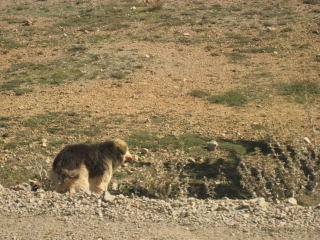 Meli
had asked us to save extra bread for the wild dogs in the mountains, and
at 6,000 ft. we found a few along the side of the road. As we passed
them, Yunus and Tomi threw bread out the bus window and doors. Some
pieces were caught by the dogs in mid-air. We also looked for wild
monkeys that in previous tours had been found in cedar groves along the
road, but this time they were absent. Meli
had asked us to save extra bread for the wild dogs in the mountains, and
at 6,000 ft. we found a few along the side of the road. As we passed
them, Yunus and Tomi threw bread out the bus window and doors. Some
pieces were caught by the dogs in mid-air. We also looked for wild
monkeys that in previous tours had been found in cedar groves along the
road, but this time they were absent.
The Atlas Mts. are famous for their cedar trees. Meli told us that
pollution is killing the cedar trees in Lebanon, so the trees in these
mountains are really important. Meli also said that the area is good for
growing herbs. A Chinese doctor comes regularly to harvest herbs and then
takes them back to Casablanca for processing.
We climbed further into the High Atlas, reaching 7,000 ft. (the peaks above
us were snow-covered at 12,000 feet). We reached the resort village of Ifrane
that by its architecture could have been located in the Bavarian alps. It
seemed very bizarre in Morocco. Land seems to be cheap here, so people only
have the construction cost of acquiring a vacation home.
There is a
University in Ifrane for the children of the wealthy. There are 3,000
students studying to be doctors and engineers at a cost of $2,000 a
month (????? is this right)?
|
|
Haji told us more about social norms in Morocco. Women marry at
age13-15; men at 15. For a woman, being a virgin is a big deal. If it is
discovered that the bride is not a virgin, she will get sent back to her
family. When a couple marry, they live with the boy’s parents and the
bride brings the household furnishings and her clothes.
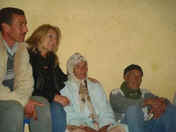
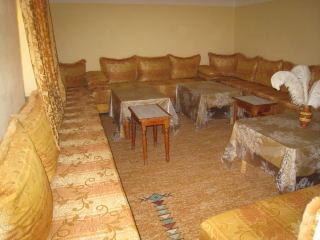 Coming
out of the Atlas Mts., we visited a Bouran village family that Meli had
come to know. The man of the house greeted us with a very warm welcome
– hand over heart. It was a plain stucco house on the outside, with a
well and squat toilet inside. The rooms were spacious and spotless. The
kitchen seemed quite modern (in a 50s style) with stove, sink, and
refrigerator. (Is this right???) We were served tea in a very
comfortable room lined with couches along the wall. There was another
room of couches, which may have been for sleeping. Coming
out of the Atlas Mts., we visited a Bouran village family that Meli had
come to know. The man of the house greeted us with a very warm welcome
– hand over heart. It was a plain stucco house on the outside, with a
well and squat toilet inside. The rooms were spacious and spotless. The
kitchen seemed quite modern (in a 50s style) with stove, sink, and
refrigerator. (Is this right???) We were served tea in a very
comfortable room lined with couches along the wall. There was another
room of couches, which may have been for sleeping.
We stopped for lunch in the city of Midelt at Hotel Ayashi. I will
always be grateful to Haji for getting me a room to lie down in for an
hour.
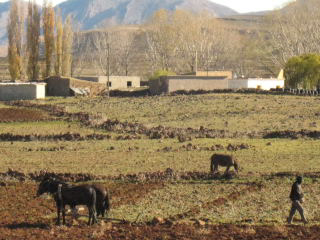
Valley of Ziz
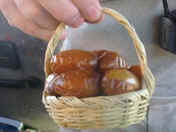 We entered the valley of Ziz – a trade center and fertile growing
area. Bottles along the side of the road signaled the presence of
beehives and honey production. People would know where to stop to buy
honey. The road that wound up and down the mountain and through a gorge
had been built by the French in 1935. The French built roads and houses
for themselves and did not care about integrating with the rest of
Morocco, although a primary We entered the valley of Ziz – a trade center and fertile growing
area. Bottles along the side of the road signaled the presence of
beehives and honey production. People would know where to stop to buy
honey. The road that wound up and down the mountain and through a gorge
had been built by the French in 1935. The French built roads and houses
for themselves and did not care about integrating with the rest of
Morocco, although a primary 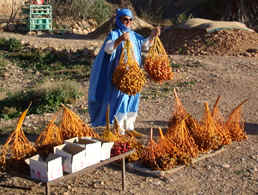 French education was offered to Moroccan
children. Since Berbers have their own language and Tuaregs and Arabs
spoke Arabic, I assume French was a learned language. It was pretty
clear that Moroccans, especially Berbers, have a great affinity for
picking up languages. There is no conflict between the Berbers, Tuaregs,
and Arabs. There is conflict with Algeria because of oil. French education was offered to Moroccan
children. Since Berbers have their own language and Tuaregs and Arabs
spoke Arabic, I assume French was a learned language. It was pretty
clear that Moroccans, especially Berbers, have a great affinity for
picking up languages. There is no conflict between the Berbers, Tuaregs,
and Arabs. There is conflict with Algeria because of oil.
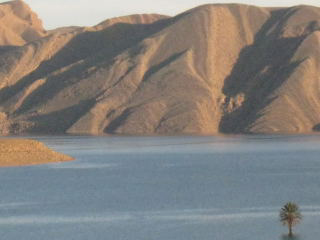 Just
outside Erfoud we came to a large lake at the edge of the desert. A lake
and sand dunes was not what I had expected to see. That night we were at
the very restful Palm Hotel in Erfoud. The next morning brought the end
of my story as I took my first dose of Cipro and immediately started to
improve. Just
outside Erfoud we came to a large lake at the edge of the desert. A lake
and sand dunes was not what I had expected to see. That night we were at
the very restful Palm Hotel in Erfoud. The next morning brought the end
of my story as I took my first dose of Cipro and immediately started to
improve.
Next Page Day 06
Morocco Tour itinerary
 Home
Page Home
Page |

 stop and a scrubby bush was my only cover. As I
started to get up from squatting, I lost my balance and fell over,
hitting my forehead on a rock. Haji came running up and got me back to
the bus where Fred got a bandage on the cut. From then on, I must say,
my ability to remember scenes was diminished. After the bus had gone on
a little ways, I realized that in the confusion after the fall, I had
left my purse back at the bush. Tomi made a really tight turn on the
narrow road and back we went. Once
stop and a scrubby bush was my only cover. As I
started to get up from squatting, I lost my balance and fell over,
hitting my forehead on a rock. Haji came running up and got me back to
the bus where Fred got a bandage on the cut. From then on, I must say,
my ability to remember scenes was diminished. After the bus had gone on
a little ways, I realized that in the confusion after the fall, I had
left my purse back at the bush. Tomi made a really tight turn on the
narrow road and back we went. Once  we got to the spot, several people
went out looking. Haji talked to some young men who were nearby and
quickly determined that the man walking away down the road had my purse.
Off he ran to catch up with him and brought both the man and my purse
back to the bus. We were all most appreciative and rewarded the man for
rescuing the bag. Haji was wonderful. My trip would have really ended
there if I had lost the bag containing money, credit cards, and
passport. Why I even thought it necessary to take the bag to the bush is
an unanswerable question.
we got to the spot, several people
went out looking. Haji talked to some young men who were nearby and
quickly determined that the man walking away down the road had my purse.
Off he ran to catch up with him and brought both the man and my purse
back to the bus. We were all most appreciative and rewarded the man for
rescuing the bag. Haji was wonderful. My trip would have really ended
there if I had lost the bag containing money, credit cards, and
passport. Why I even thought it necessary to take the bag to the bush is
an unanswerable question.
 So,
on with the journal. As we climbed the Atlas Mountains, we saw a group
of Bedouin women and children at the side of the road with their
animals. One young woman was carrying a baby lamb. With some dirhan
changing hands, we could take their pictures. There were no men in the
group – we assumed they were off tending the sheep. Further on we
spotted a black Berber tent and stopped to investigate. The tent itself
was being used to shelter
So,
on with the journal. As we climbed the Atlas Mountains, we saw a group
of Bedouin women and children at the side of the road with their
animals. One young woman was carrying a baby lamb. With some dirhan
changing hands, we could take their pictures. There were no men in the
group – we assumed they were off tending the sheep. Further on we
spotted a black Berber tent and stopped to investigate. The tent itself
was being used to shelter  farm
and household equipment – very rustic. There was a man in front of the
nearby small stucco house and with more dirhan exchange we could go
through it. It was very rustic with a propane or kerosene stove on the
kitchen floor for cooking and another room covered with rugs for sitting
and sleeping use. The Bedouin are here now because there has been rain
and the grass is green. There is no regular water supply and they have
to bring in water weekly by truck.
farm
and household equipment – very rustic. There was a man in front of the
nearby small stucco house and with more dirhan exchange we could go
through it. It was very rustic with a propane or kerosene stove on the
kitchen floor for cooking and another room covered with rugs for sitting
and sleeping use. The Bedouin are here now because there has been rain
and the grass is green. There is no regular water supply and they have
to bring in water weekly by truck. Meli
had asked us to save extra bread for the wild dogs in the mountains, and
at 6,000 ft. we found a few along the side of the road. As we passed
them, Yunus and Tomi threw bread out the bus window and doors. Some
pieces were caught by the dogs in mid-air. We also looked for wild
monkeys that in previous tours had been found in cedar groves along the
road, but this time they were absent.
Meli
had asked us to save extra bread for the wild dogs in the mountains, and
at 6,000 ft. we found a few along the side of the road. As we passed
them, Yunus and Tomi threw bread out the bus window and doors. Some
pieces were caught by the dogs in mid-air. We also looked for wild
monkeys that in previous tours had been found in cedar groves along the
road, but this time they were absent.
 Coming
out of the Atlas Mts., we visited a Bouran village family that Meli had
come to know. The man of the house greeted us with a very warm welcome
– hand over heart. It was a plain stucco house on the outside, with a
well and squat toilet inside. The rooms were spacious and spotless. The
kitchen seemed quite modern (in a 50s style) with stove, sink, and
refrigerator. (Is this right???) We were served tea in a very
comfortable room lined with couches along the wall. There was another
room of couches, which may have been for sleeping.
Coming
out of the Atlas Mts., we visited a Bouran village family that Meli had
come to know. The man of the house greeted us with a very warm welcome
– hand over heart. It was a plain stucco house on the outside, with a
well and squat toilet inside. The rooms were spacious and spotless. The
kitchen seemed quite modern (in a 50s style) with stove, sink, and
refrigerator. (Is this right???) We were served tea in a very
comfortable room lined with couches along the wall. There was another
room of couches, which may have been for sleeping.
 We entered the valley of Ziz – a trade center and fertile growing
area. Bottles along the side of the road signaled the presence of
beehives and honey production. People would know where to stop to buy
honey. The road that wound up and down the mountain and through a gorge
had been built by the French in 1935. The French built roads and houses
for themselves and did not care about integrating with the rest of
Morocco, although a primary
We entered the valley of Ziz – a trade center and fertile growing
area. Bottles along the side of the road signaled the presence of
beehives and honey production. People would know where to stop to buy
honey. The road that wound up and down the mountain and through a gorge
had been built by the French in 1935. The French built roads and houses
for themselves and did not care about integrating with the rest of
Morocco, although a primary  French education was offered to Moroccan
children. Since Berbers have their own language and Tuaregs and Arabs
spoke Arabic, I assume French was a learned language. It was pretty
clear that Moroccans, especially Berbers, have a great affinity for
picking up languages. There is no conflict between the Berbers, Tuaregs,
and Arabs. There is conflict with Algeria because of oil.
French education was offered to Moroccan
children. Since Berbers have their own language and Tuaregs and Arabs
spoke Arabic, I assume French was a learned language. It was pretty
clear that Moroccans, especially Berbers, have a great affinity for
picking up languages. There is no conflict between the Berbers, Tuaregs,
and Arabs. There is conflict with Algeria because of oil. Just
outside Erfoud we came to a large lake at the edge of the desert. A lake
and sand dunes was not what I had expected to see. That night we were at
the very restful Palm Hotel in Erfoud. The next morning brought the end
of my story as I took my first dose of Cipro and immediately started to
improve.
Just
outside Erfoud we came to a large lake at the edge of the desert. A lake
and sand dunes was not what I had expected to see. That night we were at
the very restful Palm Hotel in Erfoud. The next morning brought the end
of my story as I took my first dose of Cipro and immediately started to
improve.